About
Have you ever sat down and asked yourself, “Well, where is it, exactly, where the deer and the antelope play?” To find the answer, you need to head to a cabin located in Smith County, Kansas, where the classic American folk song “Home on the Range” is claimed to have originated.
As with most great works of art, “Home on the Range” was originally drafted by an otolaryngologist. Dr. Brewster M. Higley VI had moved from Indiana to a cabin on the banks of West Beaver Creek. Inspired by the natural beauty of his new surroundings, he wrote a poem he titled “My Western Home.” While Dr. Higley was operating on a man with a gunshot wound, a friend of the patient read the poem and said he should publish it. Dr. Higley published it in the Smith County Pioneer in 1874 (although a friend recalled seeing it in 1873). Soon after, he gave “My Western Home” to a friend named Daniel E. Kelley, a fiddle player and member of the Harlan Brothers Orchestra. Dan Kelley then set the poem to music. Notably, at no point did the poem contain the phrase “home on the range."
How did this rural doctor’s poem become an anthem for the West? It took a half-century of oral history, some investigation, and more than one instance of threatened litigation and plagiarism. In short, the song became a regional hit in North Central Kansas, where it was picked up and shared along the Chisholm Trail to as far as Texas, becoming part of the folklore canon as time passed. Eventually, famed folklorist and ethnographer John A. Lomax recorded the song in 1908, and his recorded version is the one we know today.
Home on the Range was frequently recorded by popular musicians, and eventually made its way to a Broadway musical. Interest in the song exploded in 1932 when newly elected president Franklin D. Roosevelt named it his favorite song. Bing Crosby recorded a hit version in 1933, and it was off to the races. Naturally, interest in the song’s origins were on the rise now that money was involved. One couple claimed they wrote a song called “My Arizona Home” in 1904, and sued for half a million dollars. Enter Samuel Moanfeldt, recording attorney and gumshoe, who led a nationwide search that traced the song back to Dr. Higley and his days on the cabin.
With its provenance settled, “Home on the Range” became Kansas’s state song in 1947, and remains an anthem today. For its 150th anniversary in 2023, the Kansas Tourism Board solicited five renditions from Kansas musicians for Kansas Day, including an emo version by the Get Up Kids. As for the Cabin, in 1973, it was listed on the National Register of Historic Places. By then, the range was in the ownership of Pete & Ellen M. Rust, a couple who cared for its preservation, eventually donating the land to a private charitable organization for its permanent upkeep. The Cabin was restored in 2014, but the range includes 240 acres of land and trails for exploring the property. You may not spot any buffalo roaming, but perhaps it may inspire a poem of your own.
Related Tags
Know Before You Go
The Home on the Range Cabin is private property, located at the end of a smooth but unpaved road, that has been generously shared with visitors as a charitable trust. Visitors are free to explore the grounds respectfully.
Community Contributors
Added By
Published
September 5, 2023





































